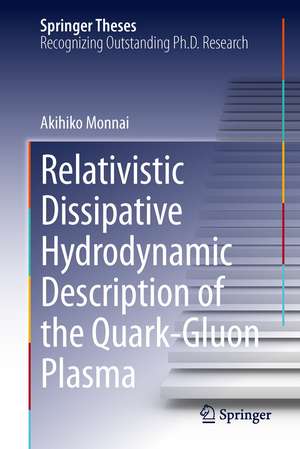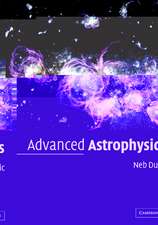Relativistic Dissipative Hydrodynamic Description of the Quark-Gluon Plasma: Springer Theses
Autor Akihiko Monnaien Limba Engleză Hardback – 30 ian 2014
The author formulates a causal theory of hydrodynamics for systems with net charges from the law of increasing entropy and a momentum expansion method. The derived equation results can be applied not only to collider physics, but also to the early universe and ultra-cold atoms.
The author also develops novel off-equilibrium hydrodynamic models for the longitudinal expansion of the QGP on the basis of these equations. Numerical estimations show that convection and entropy production during the hydrodynamic evolution are key to explaining excessive charged particle production, recently observed at the Large Hadron Collider. Furthermore, the analyses at finite baryon density indicate that the energy available for QGP production is larger than the amount conventionally assumed.
| Toate formatele și edițiile | Preț | Express |
|---|---|---|
| Paperback (1) | 633.35 lei 43-57 zile | |
| Springer – 27 aug 2016 | 633.35 lei 43-57 zile | |
| Hardback (1) | 639.41 lei 43-57 zile | |
| Springer – 30 ian 2014 | 639.41 lei 43-57 zile |
Din seria Springer Theses
- 18%
 Preț: 997.88 lei
Preț: 997.88 lei -
 Preț: 389.88 lei
Preț: 389.88 lei - 15%
 Preț: 646.94 lei
Preț: 646.94 lei - 18%
 Preț: 943.43 lei
Preț: 943.43 lei -
 Preț: 399.29 lei
Preț: 399.29 lei - 18%
 Preț: 944.99 lei
Preț: 944.99 lei - 15%
 Preț: 636.80 lei
Preț: 636.80 lei - 18%
 Preț: 941.05 lei
Preț: 941.05 lei - 15%
 Preț: 643.16 lei
Preț: 643.16 lei - 15%
 Preț: 642.68 lei
Preț: 642.68 lei - 18%
 Preț: 1103.62 lei
Preț: 1103.62 lei - 20%
 Preț: 558.82 lei
Preț: 558.82 lei - 18%
 Preț: 1112.30 lei
Preț: 1112.30 lei - 18%
 Preț: 944.19 lei
Preț: 944.19 lei - 18%
 Preț: 1109.92 lei
Preț: 1109.92 lei - 18%
 Preț: 1217.27 lei
Preț: 1217.27 lei - 15%
 Preț: 640.06 lei
Preț: 640.06 lei - 15%
 Preț: 636.45 lei
Preț: 636.45 lei - 15%
 Preț: 640.06 lei
Preț: 640.06 lei - 15%
 Preț: 640.88 lei
Preț: 640.88 lei -
 Preț: 389.70 lei
Preț: 389.70 lei - 20%
 Preț: 563.89 lei
Preț: 563.89 lei -
 Preț: 393.35 lei
Preț: 393.35 lei - 15%
 Preț: 637.93 lei
Preț: 637.93 lei - 15%
 Preț: 641.85 lei
Preț: 641.85 lei - 18%
 Preț: 1225.94 lei
Preț: 1225.94 lei - 20%
 Preț: 551.36 lei
Preț: 551.36 lei - 18%
 Preț: 1229.10 lei
Preț: 1229.10 lei - 15%
 Preț: 639.25 lei
Preț: 639.25 lei - 18%
 Preț: 999.45 lei
Preț: 999.45 lei - 15%
 Preț: 640.06 lei
Preț: 640.06 lei - 18%
 Preț: 1220.45 lei
Preț: 1220.45 lei - 18%
 Preț: 1116.26 lei
Preț: 1116.26 lei - 18%
 Preț: 1110.72 lei
Preț: 1110.72 lei - 18%
 Preț: 1000.87 lei
Preț: 1000.87 lei - 18%
 Preț: 891.17 lei
Preț: 891.17 lei - 15%
 Preț: 640.06 lei
Preț: 640.06 lei - 5%
 Preț: 1154.07 lei
Preț: 1154.07 lei - 15%
 Preț: 635.96 lei
Preț: 635.96 lei - 15%
 Preț: 640.88 lei
Preț: 640.88 lei -
 Preț: 387.20 lei
Preț: 387.20 lei - 18%
 Preț: 1109.92 lei
Preț: 1109.92 lei -
 Preț: 385.25 lei
Preț: 385.25 lei -
 Preț: 385.25 lei
Preț: 385.25 lei - 18%
 Preț: 1112.30 lei
Preț: 1112.30 lei - 18%
 Preț: 999.45 lei
Preț: 999.45 lei -
 Preț: 386.99 lei
Preț: 386.99 lei - 15%
 Preț: 637.13 lei
Preț: 637.13 lei - 20%
 Preț: 554.20 lei
Preț: 554.20 lei - 20%
 Preț: 555.57 lei
Preț: 555.57 lei
Preț: 639.41 lei
Preț vechi: 752.24 lei
-15% Nou
122.35€ • 128.07$ • 101.83£
Carte tipărită la comandă
Livrare economică 31 martie-14 aprilie
Specificații
ISBN-10: 4431547975
Pagini: 152
Ilustrații: XXI, 127 p. 29 illus., 28 illus. in color.
Dimensiuni: 155 x 235 x 14 mm
Greutate: 0.39 kg
Ediția:2014
Editura: Springer
Colecția Springer
Seria Springer Theses
Locul publicării:Tokyo, Japan
Public țintă
ResearchCuprins
Notă biografică
Textul de pe ultima copertă
The author formulates a causal theory of hydrodynamics for systems with net charges from the law of increasing entropy and a momentum expansion method. The derived equation results can be applied not only to collider physics, but also to the early universe and ultra-cold atoms.
The author also develops novel off-equilibrium hydrodynamic models for the longitudinal expansion of the QGP on the basis of these equations. Numerical estimations show that convection and entropy production during the hydrodynamic evolution are key to explaining excessive charged particle production, recently observed at the Large Hadron Collider. Furthermore, the analyses at finite baryon density indicate that the energy available for QGP production is larger than the amount conventionally assumed.
Caracteristici
Descriere
This thesis presents theoretical and numerical studies on phenomenological description of the quark-gluon plasma (QGP), a many-body system of elementary particles. The author formulates a causal theory of hydrodynamics for systems with net charges from the law of increasing entropy and a momentum expansion method. The derived equation results can be applied not only to collider physics, but also to the early universe and ultra-cold atoms. The author also develops novel off-equilibrium hydrodynamic models for the longitudinal expansion of the QGP on the basis of these equations. Numerical estimations show that convection and entropy production during the hydrodynamic evolution are key to explaining excessive charged particle production, recently observed at the Large Hadron Collider. Furthermore, the analyses at finite baryon density indicate that the energy available for QGP production is larger than the amount conventionally assumed.









